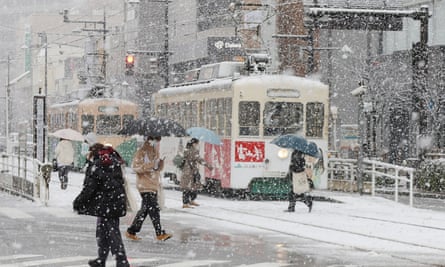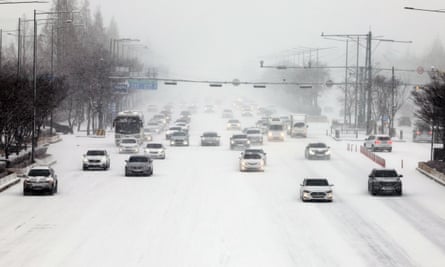Weather authorities in Japan and the Korean peninsula have issued warnings over freezing temperatures and gales that have killed at least one person, and stranded thousands.
Severe cold weather has already caused fatalities, havoc and record low temperatures across the region in the last fortnight, with at least 124 people dead in Afghanistan and record lows of -53C in northeastern China.
Large parts of Japan are now in the grip of the severe cold spell, with some areas expected to experience their lowest temperatures for a decade. On Wednesday chief cabinet secretary Hirokazu Matsuno said one person had died as a result of the storm, and two other deaths were under investigation. In the Korean peninsula, temperatures of -25C were recorded near the border between North and South Korea on Tuesday.
Heavy snowfall was predicted in central Japan and in the country’s north-east for most of Wednesday, while winds could reach up to 126 kph areas across the country, the country’s meteorological agency said. In the 24 hours to Wednesday morning, a record 93cm of snow was recorded in the city of Maniwa.

In western Japan, some rail passengers were left stranded for several hours on Tuesday, according to West Japan Railway, while domestic airlines said they would cancel more than 200 flights Wednesday. Bullet train services in the country’s north-east will also be suspended, the Kyodo news agency said.
The Japan meteorological agency has said that some parts of the country could see their lowest temperatures for 10 years, and warned that the cold snap would continue until Thursday, with blizzards and violent winds expected along the Japan Sea coast.
Strong winds may also be behind the sinking of a Hong Kong-registered cargo ship in the seas between western Japan and South Korea’s Jeju island on Wednesday morning, Reuters reported. Thirteen of the 22 crew members on board had been rescued but a search was continuing.
Officials have urged people to avoid non-essential journeys and to watch out for icy road conditions, public broadcaster NHK said. They have also warned that water pipes could freeze.
Subzero temperatures are expected Wednesday morning in Hokkaido, Japan’s northernmost main island, and as far south as Kyushu. The mercury could drop to -3C in Tokyo and -2C in the western city of Osaka.
Frigid conditions are also being experienced across the Korean peninsula. South Korea’s meteorological administration issued a special “cold wave” warning on Tuesday, as temperatures dropped as low as -16 C in Seoul and -25 C near the North Korean border on the coldest day of the season so far.
North Korean authorities have issued extreme cold weather warnings for the entire country, with temperatures forecast to drop to “dangerous lows” in some of its poorest regions, NK News reported.

The website quoted North Korea’s central radio broadcaster as saying that temperatures in the north of the country could dip below -30 C. In the capital, Pyongyang, the temperature was -19C early Wednesday, well below average for this time of the year, NK News added.
The weather system has seen temperatures plunge below average across the region. In the last two weeks at least 124 people have died in Afghanistan in the freezing conditions. State officials told the BBC the weather was coldest recorded in decades, with parts of the country were completely cut off by snow. It has also killed about 7,000 head of livestock.
Parts of China have also seen their coldest days on record, including the town of Mohe, in the norther province of Heilongjiang, which dropped to -53C. On Tuesday authorities issued a “blue” warning – the lowest of four levels for severe weather.
The cold front saw temperatures in China plunge up to 16C below average. On Tuesday the meteorological agency warned that even as the cold wave dissipated, temperatures in central and eastern areas would stay below average for the next ten days or so.
In northern and central Taiwan, temperatures also plummeted with snowfall in some areas.
Additional research by Chi Hui Lin

 1 year ago
159
1 year ago
159










 English (US)
English (US)